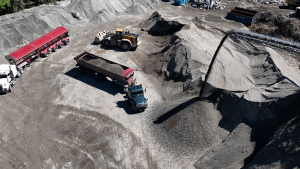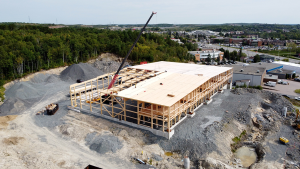Increased attention being paid to mass timber construction (MTC) is resulting in questions as to whether MTC is the silver bullet to the construction industry’s GHG and carbon emissions problem.
Wood structures will get bigger and taller over the next several years as codes around the world accept their structural characteristics. However, even those companies who supply mass timber components admit that wood is not the answer to every project.
“There is a limit to what mass timber (MT) can achieve. We have to stay realists,” says Dominique Briand, Structure Fusion president and general manager, a mass timber component supplier in Saint-Augustin-de-Desmaures, Que. “There are certain heights where pure MT doesn’t make sense anymore.” Briand told the Daily Commercial News that he believes that hybrid solutions bringing mass timber together with steel and concrete are more realistic proposals.
Facts and figures have been flying around concerning the projected growth of the world’s population, the demand for new construction in urban areas, and the industry’s contribution to GHGs. “By 2060, two thirds of the expected population of 10 billion will live in cities,” says the non-profit organization Architecture 2030. “We cannot meet climate goals without also eliminating embodied carbon emissions by 2050.”
Many consider mass timber as the industry’s panacea. It’s light, strong, visually attractive, fire resistant and embeds carbon emissions effectively. The use of prefabricated MT components such as walls, floors, and columns, results in a streamlined on-site assembly process requiring fewer workers and fewer trucks idling curb side.
However, it is not a slam-dunk. In July 2018, the National Ready Mixed Concrete Association (NRMCA) urged the International Code Council (ICC) to vote against an International Building Code (IBC) proposal allowing cross laminated timber (CLT) to be used in buildings up to 18-storeys. NRMCA Board Chairman
Allen Hamblen, said earlier in a 2016 media release, “Simply because wood is abundant does not mean it is the right choice for safe growth. Wood burns, rots and molds, and that is not a product we want in schools, multi-family housing, or retirement homes.” However, the proposal was passed and will be incorporated into the 2021 IBC edition.
MTC in North America may be growing but it remains in its infancy, well behind Europe in terms of the size and scope of MTC projects built and under consideration.
This is partly due to the maturity of the European market mass timber supply chain, according to Briand. In fact, Briand’s company imports most of its mass timber products from European suppliers.
The problem is largely the lack of scale in North America, both in the supply chain and the size of trees available for harvesting, explains Briand. “The number of laminators in Europe is just so large and their market so organized that they have better quality control, reliability and prices. The economic reality is that it is cheaper to import from Europe.”
In terms of tree size, Briand uses the analogy of using toothpicks instead of coffee sticks to produce laminated components when comparing North America to Europe. “More operations are needed with smaller wood pieces. It costs more money to produce glulam and CLT given the nature of our forestry.” In contrast, European forests are owned and managed privately for the most part. This results in more leeway relating to the harvest of large old growth species, despite legal controversies surrounding certain forestry activities, notably in Romania.
Bruno Di Lenardo, Canadian Construction Materials Centre (CCMC) evaluation officer, thinks otherwise, suggesting it’s more about a difference in approach between North America and Europe. “Europe has not commoditized mass timber components the way it has been done in North America,” he told the Daily Commercial News. “In Canada we have standards in conjunction with the U.S. and we have written the design rules. In Europe they don’t have specific design rules.”
Di Lenardo believes, however, that North America will catch up. “We are ready for volume. We design case-by-case, but the products are becoming universal and generic.”











Recent Comments